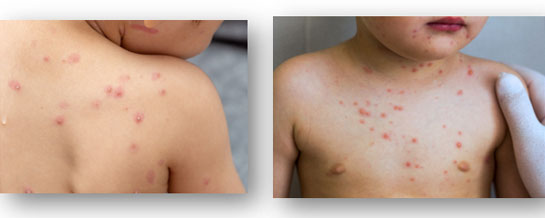How to Care for Your Child with a Chicken Pox
This leaflet will provide you with information about chickenpox causes, symptoms, diagnosis, treatment and home care advice.

What is chickenpox?
- Chickenpox is a common and usually mild infection that is most common in children under the age of 10.
- It is more prevalent in winter and spring.
What are the causes of chickenpox?
Chickenpox is caused by a virus called Varicella Zoster and spreads from one child to another by droplets from the nose and mouth and by touching surfaces that have been touched by an infected child.
What are the symptoms of chicken pox?
Children with chicken pox may have the following symptoms:
- Fever – May start before the appearance of rash
- Itchy rash made up of Fluid filled blisters that can appear all over your child’s body but most notable on the stomach, chest, face, scalp, behind the ears, arms and legs.
- The blisters dry out after 2 or 3 days and crust over.
- Child may be less active and have reduced appetite
- Child my feel unwell or have an achy arms and legs.
How is chicken pox diagnosed?
- The doctor will ask few questions about your child’s health and examine your child. Your child doctor will decide if further investigation or blood tests are needed.
- Chicken pox is usually diagnosed by the characteristic appearance of the rash.
How is chicken pox treated?
- Chicken pox treatment includes treatment of the symptoms such as the fever and itching.
- The virus itself does not require specific antibiotics
- Antihistamines can be used for itching.
- Apply calamine lotion or cooling gels to reduce the itching.
Home care advice:
- Use paracetamol to treat pain and high fever.
- Avoid Ibuprofen because it can occasionally cause skin reactions in children with chicken pox.
- Keep your child well hydrated.
- Never give aspirin to a child with chicken pox.
- Put socks or gloves on your child’s hands to reduce scratching, especially at night.
When should I seek medical advice or go to the Emergency Department:
Seek medical advice if your child:
- Develops spreading redness and pain around the blisters or spots.
- Is drowsy, has problems with balance or walking,
- has severe headaches,
- Is confused or irritable.
- Has difficulty walking.
- Has a fever lasting more than 5 days.

